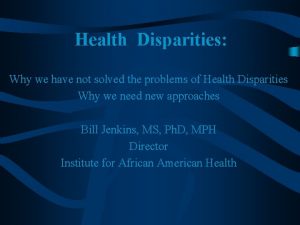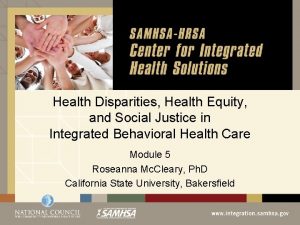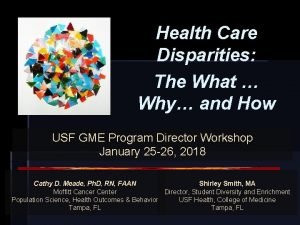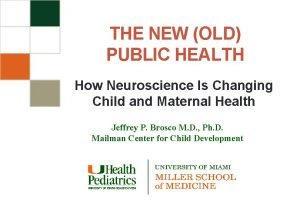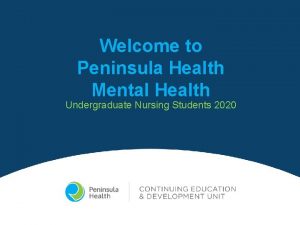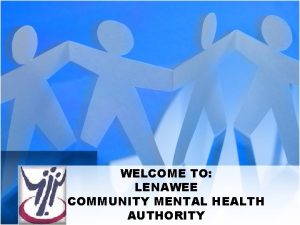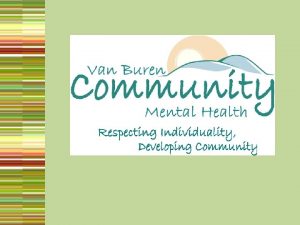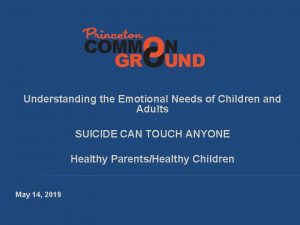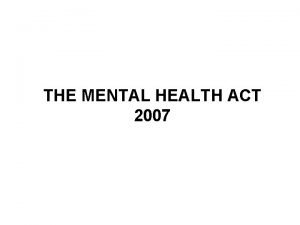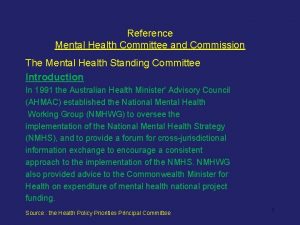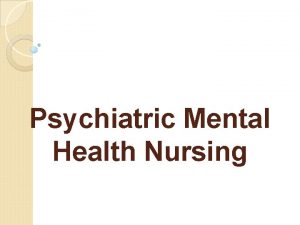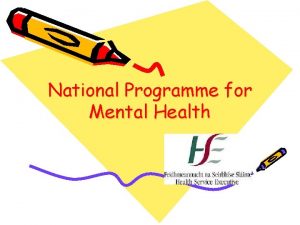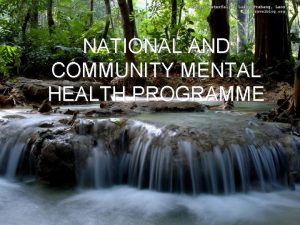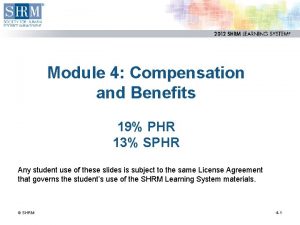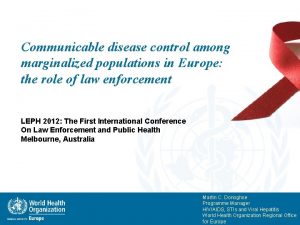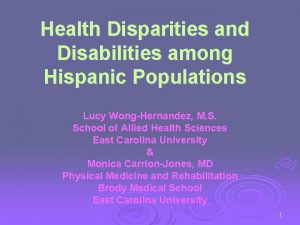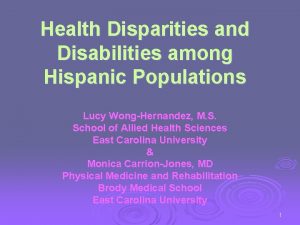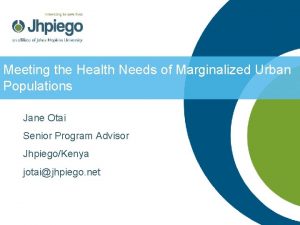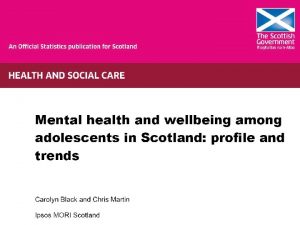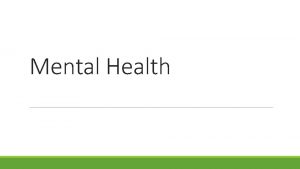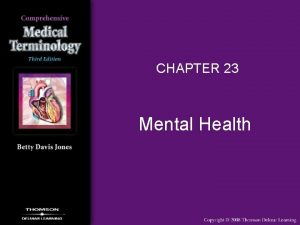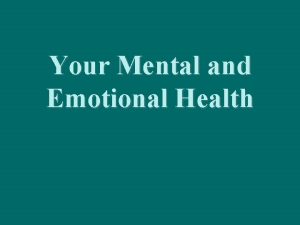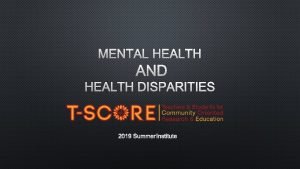MENTAL HEALTH DISPARITIES AMONG MARGINALIZED POPULATIONS Shruti Revankar






























- Slides: 30

MENTAL HEALTH DISPARITIES AMONG MARGINALIZED POPULATIONS Shruti Revankar and Jerome Jeevarajan

TEST YOUR KNOWLEDGE

What percentage of U. S. adults with a mental health condition received treatment? ■ 41% ■ Among adults with a severe mental health condition, 62. 9%

What is the average loss in life expectancy for bipolar disorder, schizophrenia, alcohol/drug abuse and depression? ■ Bipolar disorder - 9 to 20 year reduction ■ Schizophrenia - 10 to 20 year reduction ■ Alcohol and/or drug abuse - 9 to 24 year reduction ■ Recurring depression - 7 to 11 year reduction To put this into perspective…heavy smokers see a 8 -10 year loss. Some of these conditions lead to an average loss of life that is equivalent to someone who smokes 20+ cigarettes a day.

How many Americans die each year from suicide? ■ ~42, 000 to 43, 000 die every year ■ Approximately 117 suicides a day ■ For each suicide, there are 25 attempts (may vary because data is hard to gather)

Mr. John Oliver the Wise https: //youtu. be/NGY 6 Dq. B 1 HX 8? t=275

HOMELESS POPULATION

Mental Health Burden within the Homeless Population ■ 20 -25% of the homeless population suffers from some form of severe mental illness ■ More than 124, 000 of the 610, 000 homeless people in the U. S. ■ A study in California determined that 15% of all people suffering from serious mental illnesses were homeless at least once in a one-year period ■ Mental health problems are a significant independent risk factor for homelessness Source: Federal Strategic Plan to Prevent and End Homelessness

Progress Being Made

Operation Safety Net ■ Street Medicine in Pittsburgh ■ First program of its kind ■ Another program: Houston outreach program started in 2011 to identify homeless individuals and assess vulnerability and signs of mental illness ■ Relocates individuals into public housing – Average wait time until move-in: 56 days

INCARCERATED POPULATION (and their families)

Mental Health Burden within the Incarcerated Population ■ 2. 2 million in U. S. jails and prisons, and another 4. 5 million on probation or parole ■ 1 of every 35 adults ■ 1 in 3 black men can expect to go to prison – intersectionality

Mental Health Burden within the Incarcerated Population ■ 72% of people in prison with a serious mental health condition also have a substance dependence issue ■ Rikers Island in New York – over 11, 000 prisoners, ~40% have a diagnosed mental health condition ■ More than all the adult patients in New York state psychiatric hospitals combined ■ PTSD, Depression, Anxiety

Progress Being Made

Improving Mental Health for the Incarcerated Population ■ Reintegration Programs ■ Students teaching GED classes to incarcerated population ■ Amachi

LGBTQ YOUTH

Mental Health Burden within the LGBTQ Youth Population ■ ~9 million LGBTQ youth ■ LGBTQ teenagers are ~6 times more likely to experience a mental health condition such as depression or generalized anxiety disorder ■ LGBTQ youth (age 10 -24) are 4 times more likely to experience suicidal ideation, attempt suicide, or engage in self-harm ■ 38 -65% of transgender individuals experience suicidal ideation

Progress Being Made

New Mental Health Resources for LGBTQ Youth ■ LGB students have fewer suicidal thoughts and attempts when schools have gay-straight alliances and policies that prohibit expressions of homophobia for 3+ years ■ The Gay and Lesbian Medical Association’s Provider Directory lists inclusive providers ■ The Trevor Project is a support network for LGBTQ youth that provides crisis intervention and suicide prevention ■ The Rainbow Access Initiative educates health care providers on LGBTQ specific issues

VETERANS

Mental Health Burden within the Veteran Population ■ 23. 4 million veterans in the U. S. ■ Quarter million Vietnam veterans with PTSD ■ 30% of active duty and reserve personnel in Iraq/Afghanistan have a mental health condition requiring treatment ■ Less than 50% of returning veterans receive any mental health care ■ Recent studies show veterans with mental health diagnoses experience increased stigma and barriers to care ■ Approximately 22 veterans die each day because of suicide ■ Veterans with PTSD or subthreshold-PTSD endorse anger, violence, and aggression significantly more than their colleagues without PTSD

Progress Being Made

Improving Mental Health for the Veteran Population ■ 117. 6% increase in treatment intensity for veterans with PTSD at the VHA since 1997 due to recent increases in PTSD treatment funding ■ Veterans Court – alternative to incarceration that focuses on mental health and drug treatment

MINORITIES

Mental Health Burden Among Asian Americans ■ Asian American women have a higher lifetime rate of suicidal thoughts ■ Asian American college students are more likely to have suicidal thoughts and to attempt suicide

Mental Health Burden Among Native Americans ■ Young native women in Alaska are 19 times more likely to die because of suicide ■ Not many studies

Mental Health Burden Among Black Americans ■ Racial and ethnic minorities are expected to become the majority in America by 2050 ■ African Americans living below the poverty level are 3 times more likely to report psychological distress ■ Higher rates of PTSD because of higher crime rates ■ Costs and lack of insurance – most common reason to not use mental health services across all racial/ethnic groups ■ Belief that mental health services will help – least common reason

Inadequate State Mental Health Budgets Source: National Alliance on Mental Illness

DISCUSSION QUESTIONS

Discussion Questions ■ What facts did you learn that you were surprised by? ■ How do you think single payer health care would improve mental health care for these marginalized populations? ■ What can be done on a campus level that targets one or more of these problems? ■ In medical school, are you given enough tools to handle mental health issues in your patients? ■ What are some flaws in our mental health system as it pertains to marginalized populations that we missed?
 Chapter 3 health wellness and health disparities
Chapter 3 health wellness and health disparities Marginalized in the bible
Marginalized in the bible 30-30-30 model of health disparities
30-30-30 model of health disparities Health disparities meaning
Health disparities meaning Health disparities meaning
Health disparities meaning 30-30-30 model of health disparities
30-30-30 model of health disparities Jama 2017
Jama 2017 Chapter 20 mental health and mental illness
Chapter 20 mental health and mental illness Mental illness mental health jeopardy
Mental illness mental health jeopardy Shruti sheladia
Shruti sheladia Master's degree vs phd
Master's degree vs phd Shruti padmanabha
Shruti padmanabha Oblique ridge tooth
Oblique ridge tooth Falguni aggarwal
Falguni aggarwal Shruti padmanabha
Shruti padmanabha Shruti bhosale
Shruti bhosale 2 west frankston
2 west frankston Lenawee community mental health authority
Lenawee community mental health authority Van buren county cmh
Van buren county cmh Chapter 3 achieving mental and emotional health answer key
Chapter 3 achieving mental and emotional health answer key Together for mental health
Together for mental health 2007 mental health act
2007 mental health act Health triangle social examples
Health triangle social examples Titles for mental health presentation
Titles for mental health presentation Health committee introduction
Health committee introduction Kings fund
Kings fund Definition of psychiatric nursing
Definition of psychiatric nursing Nursing care plan evaluation examples
Nursing care plan evaluation examples Mental health programme
Mental health programme National mental health programme objectives
National mental health programme objectives Benefits of phr
Benefits of phr


